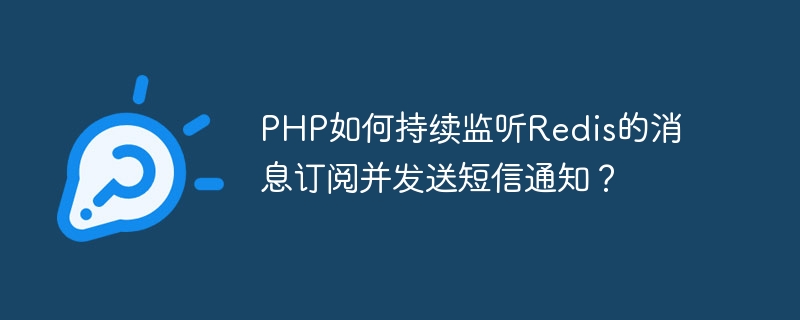

How does PHP continue to monitor Redis message subscriptions and send SMS notifications?
With the development of the Internet and the continuous expansion of application scenarios, real-time notifications have become one of the essential functions in many applications. Among real-time notifications, SMS notifications are a widely used method that can deliver key information to users in a timely manner. This article will introduce how to continuously monitor Redis message subscriptions in PHP and send messages to users through SMS notifications.
First, we need to build a Redis server as a message publishing and subscription center. For methods of setting up a Redis server locally, please refer to official documents or other tutorials. Next, we need to use the Redis extension library in PHP to implement the message publishing and subscribing functions. You can install the Redis extension library in the following way:
pecl install redis
Then add the following configuration item in the php.ini file to enable the Redis extension:
extension=redis.so
Next, we will write a PHP script that The script will continue to listen to Redis message subscriptions and send SMS notifications when messages are received.
<?php
// 引入Redis扩展
require "redis/autoload.php";
use Redis;
// 配置Redis服务器信息
$redis = new Redis();
$redis->connect('127.0.0.1', 6379);
// 订阅消息
$redis->subscribe(['message_channel'], function($redis, $channel, $message) {
// 这里可以添加发送短信的逻辑
send_sms($message);
});
function send_sms($message) {
// 发送短信的相关逻辑,这里只是一个示例
$sms_api_key = 'your_sms_api_key';
$sms_api_secret = 'your_sms_api_secret';
$sms_content = '您收到一条新消息:' . $message;
// 调用短信接口发送短信
// ...
// 这里可以使用第三方的短信接口或者自己搭建短信服务进行发送
// ...
echo "已发送短信: $sms_content
";
}
// 执行订阅操作,开始监听Redis消息
$redis->close();
?>In the above code, we use the subscribe() method provided by the Redis extension to subscribe to the message. Note that the subscribe() method is a blocking method and will wait until new messages are received. When a message is received, the send_sms() function is called to send an SMS notification.
In the send_sms() function, we can write specific SMS sending logic. Here is just a simple example. You can use your own SMS interface or a third-party SMS service to send SMS messages.
Finally, close the Redis connection through the $redis->close() method at the end of the script to ensure that the script can continue to run.
Through the above code example, we can see how to use PHP to continuously monitor Redis message subscriptions and send messages to users through SMS notifications. In this way, we can deliver important information to users in a timely manner in real-time notification scenarios.
The above is the detailed content of How does PHP continue to monitor Redis message subscriptions and send SMS notifications?. For more information, please follow other related articles on the PHP Chinese website!